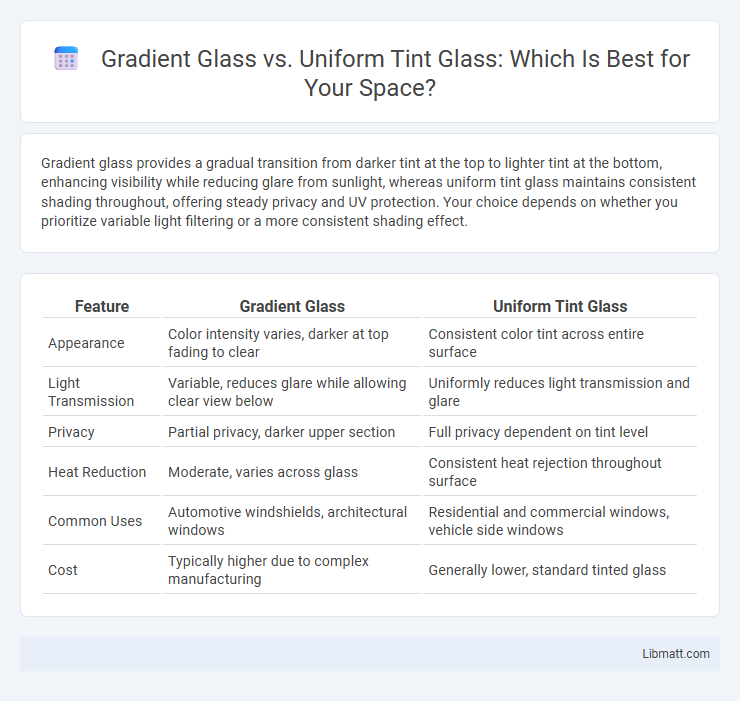Gradient glass provides a gradual transition from darker tint at the top to lighter tint at the bottom, enhancing visibility while reducing glare from sunlight, whereas uniform tint glass maintains consistent shading throughout, offering steady privacy and UV protection. Your choice depends on whether you prioritize variable light filtering or a more consistent shading effect.
Table of Comparison
| Feature | Gradient Glass | Uniform Tint Glass |
|---|---|---|
| Appearance | Color intensity varies, darker at top fading to clear | Consistent color tint across entire surface |
| Light Transmission | Variable, reduces glare while allowing clear view below | Uniformly reduces light transmission and glare |
| Privacy | Partial privacy, darker upper section | Full privacy dependent on tint level |
| Heat Reduction | Moderate, varies across glass | Consistent heat rejection throughout surface |
| Common Uses | Automotive windshields, architectural windows | Residential and commercial windows, vehicle side windows |
| Cost | Typically higher due to complex manufacturing | Generally lower, standard tinted glass |
Introduction to Gradient Glass and Uniform Tint Glass
Gradient glass features a gradual transition from transparent to tinted, allowing for enhanced light control and aesthetic appeal often used in automotive and architectural applications. Uniform tint glass maintains consistent shading throughout its surface, providing steady glare reduction and privacy suitable for residential windows and office partitions. Your choice between gradient and uniform tint glass depends on desired light modulation and design preference.
Defining Gradient Glass: Features and Applications
Gradient glass features a gradual transition in tint density, darkening at the top and becoming lighter towards the bottom, offering enhanced glare reduction while maintaining visibility. Commonly used in automotive windows and architectural facades, it optimizes comfort by blocking harsh sunlight without compromising natural light. Your choice of gradient glass can improve energy efficiency and visual appeal compared to uniform tint glass, which provides consistent shading but lacks the dynamic light control gradient glass offers.
Understanding Uniform Tint Glass: Characteristics and Uses
Uniform tint glass features a consistent coloration throughout the entire pane, providing even light reduction and glare control. This type of glass is commonly used in residential and commercial windows to enhance privacy, reduce heat gain, and protect interiors from UV damage. Your choice of uniform tint glass ensures a balanced aesthetic while maintaining effective solar control and energy efficiency.
Aesthetic Differences: Gradient vs Uniform Tint Glass
Gradient glass features a smooth transition from darker to lighter shades, enhancing visual depth and allowing natural light to enter while reducing glare. Uniform tint glass offers consistent color and light reduction across the entire surface, creating a sleek and modern aesthetic with predictable shading. Your choice depends on whether you prefer dynamic light variation or steady, even tinting for architectural and design purposes.
Light Control and Privacy Comparison
Gradient glass offers superior light control by gradually reducing sunlight intensity from top to bottom, making it ideal for spaces needing natural light without glare. Uniform tint glass provides consistent shading throughout, ensuring steady privacy but potentially limiting visibility in darker areas. Your choice depends on whether balanced daylight and nuanced privacy or uniform shade and privacy are more important for your environment.
Energy Efficiency: Gradient Glass vs Uniform Tint Glass
Gradient glass enhances energy efficiency by varying tint intensity across the pane, reducing solar heat gain where it's most intense while allowing natural light in less exposed areas. Uniform tint glass provides consistent shading, lowering overall heat transmission but potentially limiting daylight and increasing reliance on artificial lighting. Choosing gradient glass often results in better thermal regulation and reduced cooling costs compared to uniform tint options.
Cost Considerations and Installation
Gradient glass typically costs more than uniform tint glass due to the complex manufacturing process required to create the varying tint levels. Installation of gradient glass often demands precise alignment and skilled labor to ensure the gradient effect is properly displayed, which can increase labor costs. Uniform tint glass is generally easier and faster to install, resulting in lower overall installation expenses.
Maintenance and Durability
Gradient glass features a varying shade that can reduce the visibility of dirt and smudges, making maintenance easier compared to uniform tint glass, which may show dust and streaks more prominently. Both types of glass offer durability, but uniform tint glass often provides better UV protection, potentially extending the lifespan of interior furnishings by minimizing sun damage. Your choice between them should consider the ease of cleaning and the level of protection you require for long-term durability.
Popular Applications in Architecture and Design
Gradient glass is widely used in architectural facades and interior partitions to enhance aesthetic appeal while controlling sunlight and reducing glare. Uniform tint glass is commonly employed in commercial buildings and residential windows for consistent light filtration and improved energy efficiency. Both types contribute to sustainable design by optimizing natural light and heat management in modern constructions.
Choosing the Right Glass for Your Project
Gradient glass offers a stylish transition from clear to tinted areas, enhancing privacy and reducing glare in specific zones, making it ideal for projects requiring both light control and aesthetic appeal. Uniform tint glass provides consistent shading and UV protection across the entire surface, suitable for applications where steady light reduction and energy efficiency are priorities. Your choice depends on balancing design preferences with functional needs such as light management, privacy, and thermal insulation.
gradient glass vs uniform tint glass Infographic

 libmatt.com
libmatt.com